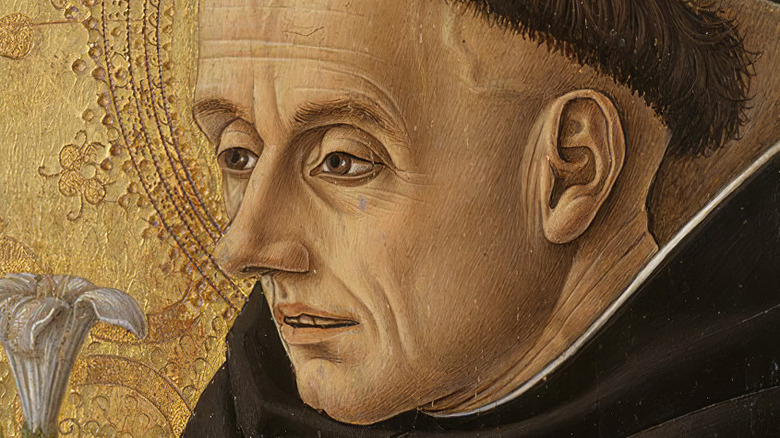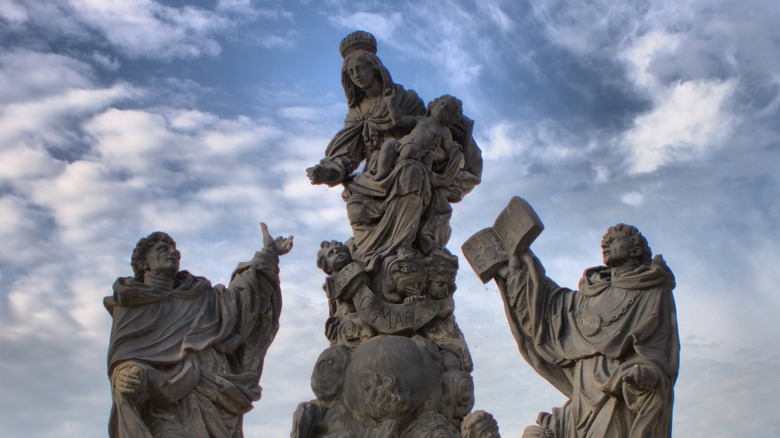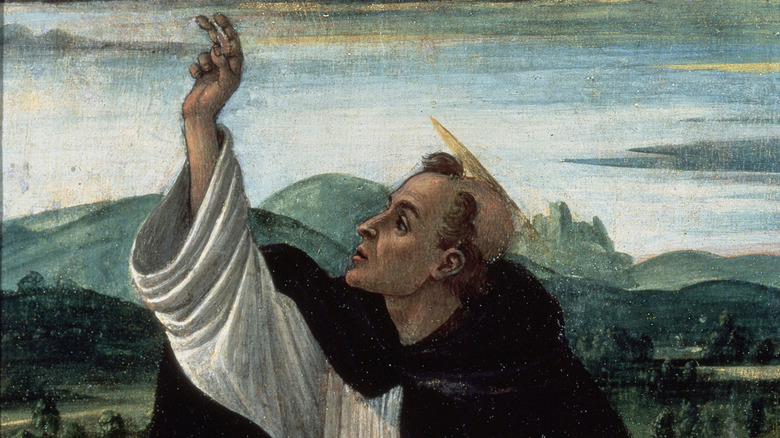St. Dominic's Offer To Sell Himself Into Slavery Was Further Proof Of His Beliefs
For many people, August 8 is just another random day full of life's typical stuff: leftover pasta, glassy-eyed Instagram scrolling, picking at fingernails while waiting for laundry to dry. But for the world's 1.36 billion Catholics (as of 2020, via University of Southern California), whether they observe the day or not, August 8 is the feast day of St. Dominic de Guzman. St. Dominic founded the Order of Preachers, aka The Dominicans, as the Dominican Friars Foundation describes. And for the record, these Dominicans aren't the folks who live in the Dominican Republic, no matter that the country got its original name, Santo Domingo, from the saint.
St. Dominic didn't set out into the wilderness saying, "I'm going to found an order of monks and also a day on August 8." He began wandering and begging in the early 13th century in an attempt to craft a "back to basics" version of Christianity, so to speak. As Wondrium Daily explains, he was deeply opposed to the Cathar movement, a Christian sect that had sprung up in southern France. As World History explains, the Cathars held beliefs that many considered heretical, including reincarnation, God being composed of male and female halves, an equal and opposing good and evil cosmic duality, and more. They were greatly influenced by traditional Persian Manichaeism, a belief system also considered heretical by Catholicism.
Lo and behold, St. Dominic wound up inspiring folks to follow his cause. More dramatically, he was even willing to sell himself into enslavement for his beliefs.
Suffering that's good for the soul
When St. Dominic left Spain and began sojourning through France from 1203 to 1206, he wanted to embody what Wondrium Daily calls an "apostolic life," a life modeled after the wandering preaching of Jesus' apostles. From there, the Dominican Friars Foundation states that St. Dominic was "struck by the need for preaching the true faith in light of the rampant heresy he encountered." The Dominican University, on the other hand, provides a more even-tempered version, saying that their Order, like Dominic, "embraces many ministries, developed as needed to bring the word of God to persons in varying societies and circumstances."
Looking at facts alone, we know that St. Dominic's followers came under sway of Spanish inquisitors who thought they might make good heretic persecutors. The Dominicans therefore became the church's original heresy-fighting tool, sanctioned to travel and root out the ungodly, particularly those of Christian offshoots like the Waldensians, Bogomils, and the aforementioned Cathars (via World History). And yes, this includes imprisoning and torturing people.
At the time, such actions were considered in line with core Christian tenets. Martyrs, and Jesus himself, had set the example: Suffering is good for the soul (the BBC has an outline). Pain is a purgative that purifies and makes one closer to the Almighty. The persecution of heretics, therefore, was God's work. In other words, when St. Dominic offered to endure the suffering of enslavement, he was partaking in a very old, well-established belief.
A ransom of voluntary enslavement
Because medieval record-keeping wasn't exactly stellar, we don't have a lot of specific details about the time St. Dominic tried to sell himself into enslavement. We do know that the incident has been given a retrofitted gloss of "heroic charity," as the Dominican Friars Foundation puts. However, not only was the offer of voluntary enslavement in line with central Christian beliefs regarding suffering, members of other orders like the Redemptorists did the same thing as a matter of course, as the Catholic Novenas App says. We're not quite sure whether or not there was a rampant spree of kidnappings and ransoms during the early 13th century, but it does make sense to pay for a life with a life. And that's exactly what St. Dominic did.
When St. Dominic offered to be enslaved, he did so to procure the release of others. We don't know who these "others" were, only that they'd been taken captive by Moors, the term used for dark-skinned Muslims, as sites like Catholic Online state. It stands to reason that these Moors might have come from northern Africa, or Al-Andalus, the region of Islamic Spain first conquered in 711 CE and occupied all the way to 1492 (via the BBC). Catholic Answers states that St. Dominic offered himself as ransom for captives twice. This, or St. Dominic's work as a heretic hunter, might be part of the reason why St. Dominic is the patron saint of people falsely accused of crimes.


